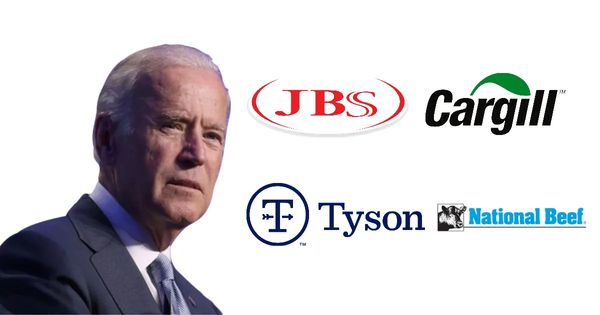.jpg?fit=outside&w=1200&h=630)
Fairer, More Competitive, and More Resilient Meat and Poultry Supply Chain
January 3, 2022
In July, President Biden signed an Executive Order on Promoting Competition in the American Economy to create a fairer, more resilient, and more dynamic economy. Over the last few decades, we’ve seen too many industries become dominated by a handful of large companies that control most of the business and most of the opportunities—raising prices and decreasing options for American families, while also squeezing out small businesses and entrepreneurs.
The meat and poultry processing sector is a textbook example, with lack of competition hurting consumers, producers, and our economy
Four large meat-packing companies control 85 percent of the beef market. In poultry, the top four processing firms control 54 percent of the market. And in pork, the top four processing firms control about 70 percent of the market. The meatpackers and processors buy from farmers and sell to retailers like grocery stores, making them a key bottleneck in the food supply chain.
When dominant middlemen control so much of the supply chain, they can increase their own profits at the expense of both farmers—who make less—and consumers—who pay more. Most farmers now have little or no choice of buyer for their product and little leverage to negotiate, causing their share of every dollar spent on food to decline. Fifty years ago, ranchers got over 60 cents of every dollar a consumer spent on beef, compared to about 39 cents today. Similarly, hog farmers got 40 to 60 cents on each dollar spent 50 years ago, down to about 19 cents today.
Even as farmers’ share of profits have dwindled, American consumers are paying more—with meat and poultry prices now the single largest contributor to the rising cost of food people consume at home.
And, when too few companies control such a large portion of the market, our food supply chains are susceptible to shocks. When COVID-19 or other disasters such as fires or cyberattacks shutter a plant, many ranchers have no other place to take their animals. Our overreliance on just a handful of giant processors leaves us all vulnerable, with any disruptions at these bottlenecks rippling throughout our food system.
Today, President Biden will meet with farmers, ranchers, and independent processors from across the country to hear from them and to announce the Biden-Harris Administration’s Action Plan for a Fairer, More Competitive, and More Resilient Meat and Poultry Supply Chain. The Action Plan includes
four core strategies for creating a more competitive, fair, resilient meat and poultry sector, with better earnings for producers and more choices and affordable prices for consumers:
The Biden-Harris Administration will dedicate $1 billion in American Rescue Plan funds for expansion of independent processing capacity. USDA reviewed nearly 450 comments received over the summer in response to its request for input on how best to increase independent processing capacity. Through their analysis of stakeholder input, USDA identified an urgent need to:
• Expand and diversify meat and poultry processing capacity;
• Increase producer income;
• Provide producers an opportunity to have ownership in processing facilities;
• Create stable, well-paying jobs in rural regions;
• Raise the bar on worker health, safety, training, and wages for meatpacking jobs;
• Spur collaboration among producers and workers;
• Prompt state, tribal, and private co-investment; and
• Provide consumers with more choices.
To these ends, USDA has increased available funding and is releasing new program details to support the meat and poultry supply chain. Specifically, the Biden-Harris Administration will:
Expand independent processing capacity:
• • Increase competition and create more options for producers and consumers in the near-term by jump-starting independent processing projects that will increase competition and enhance the resiliency of the food supply chain. This new processing capacity will build momentum in a currently concentrated market. For example, 50 beef slaughter plants owned by just a handful of companies currently process nearly all the cattle in the United States. USDA will provide gap financing grants totaling up to $375 million for independent processing plant projects that fill a demonstrated need for more diversified processing capacity.
o USDA will publish a Request for Proposals for Phase I of this initiative this Spring. Phase I will invest approximately $150 million to jump-start an estimated 15 projects, focused on deploying financial support for projects with the greatest near-term impact. USDA will deploy an additional $225 million to support additional projects in Phase II, which will open in Summer 2022. USDA will also ensure these funds truly expand capacity outside the largest meat and poultry processors, funding only independent operations.
• Strengthen the financing systems for independent processors. USDA will work with lenders to make more capital available to independent processors that need credit. To address the credit access gap, USDA will deploy up to $275 million in partnership with lenders that will, in turn, provide loans and other support to businesses at rates and on terms that increase access to long-term, affordable capital. USDA will solicit applications from potential partners by Summer 2022, with an initial focus on lenders that provide financing in underserved communities.
• Back private lenders that invest in independently owned food processing and distribution infrastructure. From cold storage to specialized equipment, building a more distributed and resilient food system requires independent producers to have access to food processing and distribution infrastructure that enables them to move their product throughout the supply chain. To assist in the financing of this infrastructure, USDA has deployed $100 million in American Rescue Plan funds, to make more than $1 billion in guaranteed loans available immediately. Applications for these guaranteed loans will be accepted until funds are expended; more information on how to apply can be found here.
Support workers and the independent processor industry
• Build a pipeline of well-trained workers and support safe workplaces with fair wages. New and expanded meat and poultry processing facility capacity will create new job opportunities in rural communities. Building a well-trained workforce and ensuring that meat and poultry processing jobs are safe requires dedicated attention and investment. USDA will dedicate $100 million to support development of a well-trained workforce, safe workplaces, and good-paying, quality jobs by working closely with partner organizations, including labor unions, with expertise in workforce development and worker health and safety.
• Promote innovation and lower barriers to entry via publicly accessible expert knowledge. Meat and poultry processing is a complex and technical sector that requires strict adherence to a host of environmental, food safety, and worker safety requirements. Creating new business models that support both workers and producers is similarly complex and time-intensive. At the same time, processors need access to new and emerging innovative practices and technologies. USDA will invest an estimated $50 million in technical assistance and research and development to help independent business owners, entrepreneurs, producers, and other groups, such as cooperatives and worker associations, create new capacity or expand existing capacity.
• Provide $100 million in reduced overtime inspection costs to help small and very small processing plants keep up with unprecedented demand. With bipartisan support in Congress, USDA is reducing the financial burden of overtime and holiday inspection fees for small and very small poultry, meat, and egg processing plants, by 30 percent and 75 percent respectively, which provide farmers and ranchers with local alternatives to process livestock
Source: The White House










